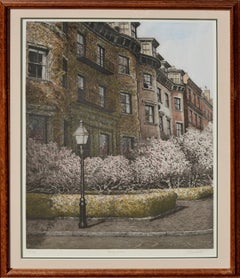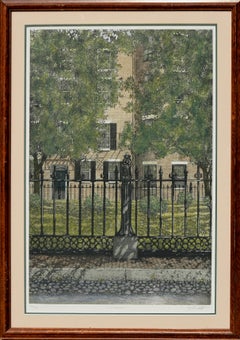John Collette On Sale
Recent Sales
1990s American Impressionist Landscape Prints
Archival Paper, Watercolor, Etching
1990s American Impressionist Landscape Prints
Etching, Ink, Archival Paper, Watercolor
John Collette for sale on 1stDibs
John Collette born in Boston, Massachusetts, on December 25, 1941. His interest in art began in early childhood when he discovered the fun and excitement of drawing and painting. His first formal art training, in junior high school, was particularly helpful to his becoming an artist because his teacher recognized his talent and gave him more demanding assignments than his classmates and generously offered to enter John's work in National Scholastic Art Competitions. Music was another of John's early interests and he studied several instruments and played in various musical groups while growing up. When he was ready for college he wanted to continue his musical studies. After passing an audition on piano, he was accepted as a music major at Boston University. In 1963, John visited Quebec City, Canada. There, he decided to do some sketches of the quaint old parts of the town. This led to his meeting a group of art students who had recently begun to exhibit their work on a narrow street. Rue du Trésor, just off the main square. They invited John to join them. He showed them the sketches he had just completed and quickly sold for a few dollars. For the next several summers, he worked in Quebec, experimenting with a wide variety of mediums and styles and finding a steady stream of buyers in the tourists who visited the city. The rest of the year, while attending Boston University, he continued to paint, selling his work through galleries in Boston and Philadelphia. His early work in watercolors and ink paved the way for the development of his distinctive hand-colored etching technique, to which he devoted himself for more than 25 years. John also did a series of paintings of the Hudson River Valley for limited edition giclee prints. John’s work is well-known in the United States and abroad. His art is included in many private, corporate and public collections. For the last 13 years of his life, he spent most of his time in New England and Hawaii. John Collette passed away in Boston in September of 1997.
Finding the Right prints-works-on-paper for You
Decorating with fine art prints — whether they’re figurative prints, abstract prints or another variety — has always been a practical way of bringing a space to life as well as bringing works by an artist you love into your home.
Pursued in the 1960s and ’70s, largely by Pop artists drawn to its associations with mass production, advertising, packaging and seriality, as well as those challenging the primacy of the Abstract Expressionist brushstroke, printmaking was embraced in the 1980s by painters and conceptual artists ranging from David Salle and Elizabeth Murray to Adrian Piper and Sherrie Levine.
Printmaking is the transfer of an image from one surface to another. An artist takes a material like stone, metal, wood or wax, carves, incises, draws or otherwise marks it with an image, inks or paints it and then transfers the image to a piece of paper or other material.
Fine art prints are frequently confused with their more commercial counterparts. After all, our closest connection to the printed image is through mass-produced newspapers, magazines and books, and many people don’t realize that even though prints are editions, they start with an original image created by an artist with the intent of reproducing it in a small batch. Fine art prints are created in strictly limited editions — 20 or 30 or maybe 50 — and are always based on an image created specifically to be made into an edition.
Many people think of revered Dutch artist Rembrandt as a painter but may not know that he was a printmaker as well. His prints have been preserved in time along with the work of other celebrated printmakers such as Pablo Picasso, Salvador Dalí and Andy Warhol. These fine art prints are still highly sought after by collectors.
“It’s another tool in the artist’s toolbox, just like painting or sculpture or anything else that an artist uses in the service of mark making or expressing him- or herself,” says International Fine Print Dealers Association (IFPDA) vice president Betsy Senior, of New York’s Betsy Senior Fine Art, Inc.
Because artist’s editions tend to be more affordable and available than his or her unique works, they’re more accessible and can be a great opportunity to bring a variety of colors, textures and shapes into a space.
For tight corners, select small fine art prints as opposed to the oversized bold piece you’ll hang as a focal point in the dining area. But be careful not to choose something that is too big for your space. And feel free to lean into it if need be — not every work needs picture-hanging hooks. Leaning a larger fine art print against the wall behind a bookcase can add a stylish installation-type dynamic to your living room. (Read more about how to arrange wall art here.)
Find fine art prints for sale on 1stDibs today.

